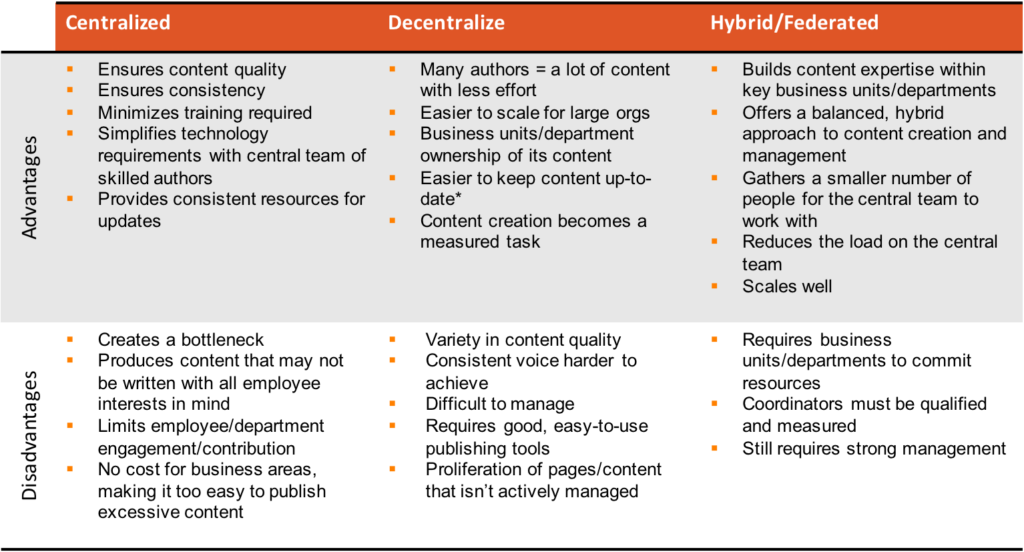Intranets need governance, like goldfish need water
Most companies have an intranet, or at least some form of online environment through which it shares information (HR, IT, policies), news (corporate, industry, employee), and employee contact information – even if the employee directory is just an Excel spreadsheet with a list of employee names, email addresses, and extension … no really, that is all it is sometimes. It is always surprising to me just how many companies spin these sites up and then virtually ignore them. When we work with clients on re-imaging their intranet and helping them set up intranet best practices; helping them build a vision for its future, one of the first question I ask is “Who owns the intranet?”. You might be shocked to know that most of the time the answer is a resounding “I don’t know” or “nobody”.
Shared ownership rarely works out well
That’s not to say that there are departments that lay claim to different parts of the site – Corporate/Internal Communications typically owns the home page, HR will proudly lay claim to all things human resources related (office closure schedule, pay day calendar, vacation policy, etc.), and IT will sometimes own up to the technology – and yes, the technology has to be considered into what makes up the intranet. But as far as true ownership goes, “where the buck stops” kind of ownership, well, that is when everyone starts looking at their phones, or their shoes, having to leave the room to take a super important phone call (really, who calls anyone anymore), or … well you get the idea.
Intranets, like so many other things in our lives – plants, pets, cars – they need to be tended to and cared for. In all of these cases – turtles to technology – without a clearly defined ownership and active management, they will start to whither and then die. Intranet governance is not something companies should do to “check it off the list”. It needs to be divined and defined by considering many factors – available resources, skills, technology, and company culture to name a few. When developed with intent, an intranet governance model provides clarity via guidelines, well defined roles and responsibilities for its contributors, managers, stakeholders, and its owner(s).
A governance model for all
Intranet governance typically comes in three models and are based on premise of content ownership:
1. Centralized Model
In this set up, one person or department has control and all decision making authority. Typically assigned to Corporate Communications, this person or group are the gatekeepers for all intranet content; nothing gets published without their involvement. Centralizing the “keeping of the intranet keys” to an individual or small group can work well for small organizations, or for intranets that are used primarily as a one-way communication tool; where it acts as a repository for employees to access information such as company policies, procedures, or shared tools such as for time or expense entry. Many companies that start down this path as their governance model quickly realize how restrictive it is, and re-organize to be more of a decentralized or hybrid model.
2. Decentralize Model
The hallmark of the decentralized governance model is that everyone can contribute content with no formal gatekeeping. There is no centralized or overall ownership for the site. The model enables all employees to contribute content in almost a wiki-like fashion. This model is well suited for smaller, flat organizations with a culture of collaboration and contribution. Larger organization that try this model often find their site turning into the “wild west” where with so much, virtually, unmanaged content, that important corporate information and the company voice gets lost.
3. Hybrid or Federated Model
As its name infers, the Hybrid or Federated model combines the best of both the Centralized and Decentralized worlds. It provides for the assignment of overall ownership of the site to one person or group, with decentralized/shared content ownership across the organization. The most common of models for mid- to large-sized companies, the Hybrid model provides the necessary dedicated and committed ownership of the site to actively manage its evolution, while allowing for many contributors to help keep the site relevant and useful to all employees.
Note: Companies can, and should, blend elements from any or all governance models to build one that suits them. If it works, then it is probably right.
The following chart provides a high level overview of pros and cons of each of these three models:

Identifying which model works best for your organization is just one of the first steps in establishing intranet governance. A well-defined governance structure also includes:
- Identification of roles and responsibilities of for management, as well as content owners and contributors.
- Technology ownership assignment – will it be just IT, or will the intranet owner put skin in the technology game?
- Defined workflows and decision making processes.
- Policies, guidelines, and standards.
- An analytics/measurement plan: what will be measured, why, and who will do what based on the stats.
- An intranet strategy or roadmap that will guide the site’s evolution.
Where to start?
There are so many things to consider; what kind, if any, type of governance you have in place now, what is working and what isn’t; your organizations culture and how it typically functions best – collaboratively, via assigned work tasks, etc.; available resources; and existing or planned intranet technology. All this is to say, a governance model shouldn’t be selected based on “what seems best”, but rather, “what IS best for the company”.
Need help deciding? Or want to learn more about intranet governance and how to set up a successful model? Then let us know. We’d love to talk to you about how our Governance Workshop or Intranet Visioning solutions could help you and your team deliver more value to the organization via a well-managed and evolutionary intranet.








